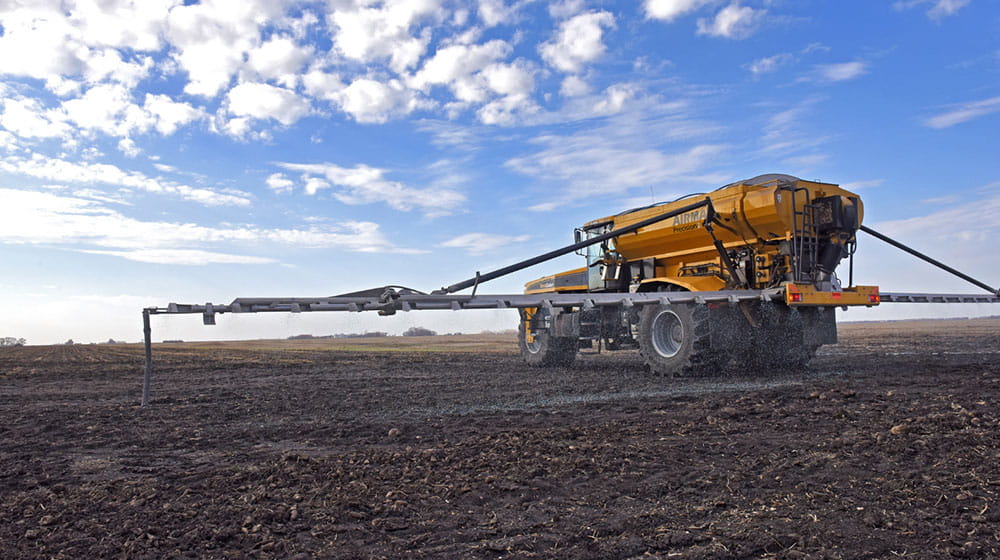Fertilizer is essential for growing a great crop. The cooperative system is dedicated to ensuring farmers have the crop nutrients they need when they need them.
In this episode of It Takes a Co-op™, Jake Niederer, senior director of risk and trading with CHS, leads a conversation with Lindsie Herzog, director of planning with CHS, and Ross Keegan, senior director of operation at CHS River Plains in South Dakota, about how proactive planning and key investments have helped cooperatives overcome challenges and deliver needed fertilizer for the growing season.
Challenges
“We need fertilizer from international sources to balance our North American supply and demand and meet the needs of all the farmers,” Neiderer says.
According to the National Minerals Information Center of the United States Geological Survey, since 2020 the U.S. has imported 6% to 13% of its total annual nitrogen consumption, 6% to 16% of annual phosphorus consumption and more than 90% of its potassium needs.
Geopolitical conflicts, shipping challenges and tariffs have created supply and price volatility, Neiderer says. Vessels loaded with fertilizer sourced from the Middle East often sail around Africa instead of transiting the Red Sea and Suez Canal into the Mediterranean Sea due to fears of being attacked by Houthi rebels, adding cost and time to the trip. Russia is a major crop nutrient supplier, but its ongoing war with Ukraine creates supply uncertainty.
“A lot of different challenges were thrown at us ... changes to shipping lanes caused by wars and some tariffs added,” Niederer says. “When you think about supply chain management and planning, there’s a lot of activity.”
Proactive planning
Proactive planning helped mitigate logistical and other challenges to meet the crop nutrients needs of farmers, Herzog says. CHS recently implemented a supply chain planning process engaging the entire crop nutrients product line. This includes studying seasonal sales and usage trends and gathering feedback from farmers about fertilizer needs months before the next growing season.
“We collect information from our wholesale and retail teams, which is relayed to the trading team so they can manage risk and strategically place volumes in the appropriate areas to meet customer demand,” Herzog says. “We ended up forecasting volumes for the [2025] season with over a 90% accuracy rate, which is one of the higher accuracies we’ve had across our whole supply chain.”
Keegan says planning paid dividends in 2025, which was noticed by farmer-owners of CHS River Plains.
Favorable weather this spring allowed many farmers to plant earlier than normal in the Dakotas, he says. The cooperative system was ready.
“We were able to work together and pull fertilizer from non-traditional points. We were able to flip trains around within the CHS system to ensure that we had enough supply for our customers,” Keegan continues. “We did not have one outage this year.”
Key investments
CHS has made several strategic investments and struck partnerships in recent years to strengthen its fertilizer supply chain, Neiderer says. These include:
- An investment in CF Industries, one of the world's largest producers of nitrogen fertilizer. The partnership provides a steady supply of domestic fertilizer. This includes the expansion of the Port Neal, Iowa, nitrogen production complex.
- A $30 million investment in the CHS deep-water port at Galveston, Texas. Improvements allow fertilizer to be offloaded from ships and into railcars at greater speed so crop nutrients will reach co-op warehouses and farm fields more quickly.
- An exclusive services agreement between CHS and Ingram Barge Company’s subsidiary, SCF Lewis and Clark Terminals LLC. The agreement provides CHS exclusive rights to fertilizer throughput at Ingram’s Municipal River Terminal in St. Louis, Mo., and for fertilizer transport services.
“The investments helped us prepare for some of the volatility thrown at us,” Niederer says.
The future
While CHS and member cooperatives successfully fulfilled crop nutrient needs for farmers in 2025, Herzog says steps are being taken to improve the fertilizer procurement and distribution process for 2026 and beyond.
“We’re looking to strengthen the connection even more between our wholesale and retail operations teams and trading and procurement teams,” she adds. “We’ll continue to look at our end-to-end network and understand our customer needs to find ways to grow.”
Each month on It Takes a Co-op, we introduce you to people working in agriculture and energy, inside and outside of CHS, whose ideas and insights will help you, and your cooperative, succeed.
Follow and listen to the show on your preferred podcast app. And watch video versions on the CHS YouTube channel. Episodes are posted monthly.
Listen on Apple Podcasts.
Listen on Spotify.
Have suggestions for topics or guests? Email them to social@chsinc.com.


 Audio Clip
Audio Clip



